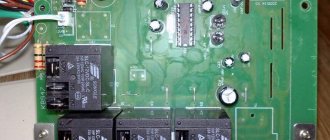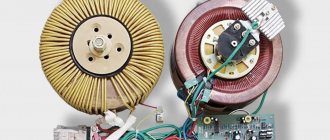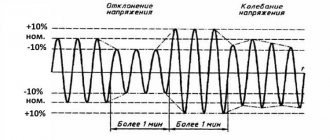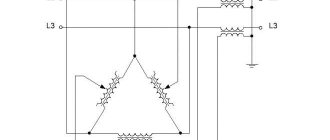- home
- Resanta stabilizers
Many people use powerful electrical appliances and also have their own homes, where you can find a large list of electrical devices. Each of the home partings is designed to work in conditions under which the voltage level does not go beyond 198-242 volts.
However, in our time there is a completely different situation. The voltage may differ from the normalized 220 volts not by 10, but by 20, or even more percent. Of course, this state of current is unacceptable for a large number of our electrical appliances.
The solution in this situation is to purchase and install a 10,000-watt voltage stabilizer, which was released by.
This stabilizer is ideal for providing stable current to all electrical appliances in your home or apartment.
Note that the company took into account the interests of many customers and made several models of voltage stabilizer with a power of 10 kW. So, you can choose either a wall relay, or a floor relay, or a floor electromechanical normalizer.
The first two differ only in appearance and have the same internal elements. They are represented by models ASN-10000N/1-Ts and ASN-10000/1-Ts.
Appearance of the device ASN-10000N/1-C
Wall stabilizer Resanta
Both have a metal body. The body of the wall stabilizer has a height of 30.5 centimeters. The depth is 19 centimeters and the width is 26 centimeters.
Compared to the body of the floor-standing model, it is flatter. For easy installation on any wall, the manufacturer has attached a bracket.
The front panel boasts the presence of:
- digital screen (shows the number of input and output volts);
- three LED indicators (network, overload and delay indicators);
- double circuit breaker for "Bypass" and "Network" modes.
The bottom side is equipped with outlets for connecting the necessary wires and a fan. There are ventilation holes on all other sides.
Helpful advice: using a wall-mounted voltage stabilizer with a power of 10,000 W is the most profitable when compared with other analogues from. The wall-mounted model allows you to save space in the room and reduces the risk of damage to its body. There is also almost no maintenance required.
What you need to connect
In addition to the stabilizer itself, you will need a number of additional materials:
- three-core cable VVGnG-Ls
The cross-section of the wire must be exactly the same as on your input cable, which comes to the main input switch or circuit breaker. Since the entire load of the house will go through it.
- three position switch
This switch, unlike simple ones, has three states:
1consumer No.1 is on 2is off 3consumer No.2 is on
You can also use a regular modular circuit breaker, but with this scheme, if you need to disconnect from the stabilizer, you will have to completely de-energize the entire house each time and reconnect the wires.
There is, of course, a bypass or transit mode, but in order to switch to it, you need to follow a strict sequence. This will be discussed in more detail below.
With this switch, you completely cut off the unit with one movement, and the house remains with light directly.
- PUGV wire of different colors
You must clearly understand that the voltage stabilizer is installed strictly before the electric meter, and not after it.
Not a single energy supplying organization will allow you to connect in another way, no matter how much you prove that by doing so, in addition to the electrical equipment in the house, you want to protect the meter itself.
The stabilizer has its own idle speed and also consumes energy, even when operating without load (up to 30 W/h and above). And this energy must be taken into account and calculated.
The second important point is that it is highly desirable that in the circuit up to the connection point of the stabilization device there is either an RCD or a differential circuit breaker.
This is recommended by all manufacturers of popular brands Resanta, Sven, Leader, Shtil, etc. It could be an introductory automatic differential for the whole house, it doesn’t matter. The main thing is that the equipment itself is protected from current leaks.
In the method described below, this option will be considered. After all, very often these devices are hung on the wall in rooms, hallways, freely accessible for touching.
And breakdown of the transformer windings to the housing is not such a rare thing.
External signs of the ASN-10000/1-C normalizer
Floor stabilizer Resanta
The Resanta brand floor relay stabilizer with the same power has a housing with different dimensions. So, it is characterized by a greater depth, which is 38.5 centimeters. The height and width are 23 and 22 centimeters, respectively.
The front side houses three indicators, a digital display, a display control button and a circuit breaker. This switch is no different from the wall stabilizer switch.
The display shows only one digit. This number can indicate either output or input voltage. The screen operating mode is selected using a special button.
On the back side there are connection terminals and a fan. The manufacturer installed two handles on the top side. “Appearance” of the ASN-10000/1-EM normalizer
If we talk about the “appearance” of the electromechanical stabilizer - ASN-10000/1-EM, then on its front side there are:
- Ammeter.
- A voltmeter that can show either the output or input volts.
- Voltmeter operating mode switch.
- Automatic switch (same as the previous two models).
- Three indicators
These indicators report different levels of input volts. The first indicator will light up when the input is more than 260 volts, the second - when the input is less than 260 and more than 140 volts. The third will report a very low voltage (less than 140 V).
On the rear panel there are terminals for connection. There are also ventilation holes on the back and sides. There is no fan.
Product range
Since various electrical appliances are produced under this brand, it is impossible to consider them all in one article. Therefore, we will focus only on the line of voltage stabilizers of the Resanta brand for household and office equipment. They are represented by the following modifications:
Types of stabilizersElectronic single-phase with digital display;
- Electromechanical;
- Digital wall mounted;
- Undervoltage;
- Household;
- Three-phase.
Single-phase devices are represented by models marked ASN 500 / 1-C. The number 500 indicates the rated voltage of the device; for the product in question this parameter is 0.5 kW. However, this line includes more than 10 samples, differing in overall dimensions and rated voltage.
Resanta voltage stabilizers of the electromechanical type have a similar marking, only at the end there are the letters EM, for example, ASN 1000/1-EM. They are also available in various modifications, differing in technical characteristics.
Watch a video about the ASN 1000/1-C model:
The line of wall stabilizers are devices with a modern design. Moreover, the models differ not only in parameters, but also in the shape of the body. It can be rectangular or with rounded corners.
Household single-phase products are the smallest devices from the Resanta stabilizer range.
S2000 series
They are presented in 4 modifications and are marked:
- C500;
- C1000;
- C1500;
- S2000.
Specifications
Despite the fact that relay and electromechanical voltage stabilizers with a power of 10,000 W work on different principles, I made it so that they are characterized by almost the same technical characteristics
Thus, the operating range of the input current ranges from 140 to 260 volts. All three models have the same power and can operate when the current frequency fluctuates between 50-60 hertz.
In situations where the voltage drops below 190, the power also decreases. Below is a graph that shows the maximum load versus power level.
Graph of maximum load versus voltage
Helpful advice: it will be better if you study this graph well and, depending on current changes, provide the appropriate load. Thanks to this, it will be possible to avoid overloading the stabilizer and significantly extend its shelf life.
Also, each of the above-mentioned voltage stabilizers boasts the presence of overload protection systems and voltages exceeding 260 V. As for the accuracy of current normalization, the best device in this regard is such a device as the ASN-10000/1-EM voltage stabilizer. It stabilizes voltage with two percent accuracy. This means that the output current will be from 215-225 V.
Relay models stabilize voltage with an accuracy of 8 percent. The output voltage range will fluctuate between 202-238 V. It is also worth paying attention to another important parameter - the stabilization speed.
For an electromechanical stabilizer, this speed is 1-2 seconds, for a relay device - 20 milliseconds. Taking this into account, in cases where very frequent current changes occur, it is recommended to use 10-kilowatt relay stabilizers.
terms of Use
Any of these stabilizers can work reliably if certain operating conditions are observed.
The manufacturer's instructions specify that each of the above models must operate at air temperatures that range from +5 to +40 degrees Celsius. The humidity level should not exceed 80 percent.
During operation, it is very important to provide access to fresh air to the device itself. To do this, there must be at least 5 centimeters of free space around the stabilizer.
Floor stabilization devices must be located at a distance of at least 50 centimeters from the wall. Any flammable object should be placed at the same distance from the stabilizer.
Ventilation openings must not be covered or exposed to sunlight.
The normalizer must be grounded.
Connection
After the room and installation location of the 10-kilowatt Resanta stabilizer meets the above requirements, it can be connected.
To carry out this process, I equipped the stabilizer with five terminals. Two of them are designated by the letter “L” and are phase, the other two are designated by the letter “N”. They are designed for connecting neutral wires. The fifth terminal is for grounding.
First, ground the device. Then the input wires are connected. The terminals for connecting input wires are marked “INPUT”. Of course, the phase cable must be connected to the “L” terminal. The neutral wire is connected to the neutral terminal.
After this, turn on the normalizer and check the presence of volts at the output. Next, turn off the stabilizer. When there is voltage at the output, connect the output wires. The connection principle is the same as for incoming wires.
When there is no output voltage, check that the input wires are connected correctly. In the worst case scenario, you should contact a service center.
Maintenance
Maintenance is a simple procedure. Once every six months, you need to check the fastenings of the input and output cables, and also clean the ventilation holes.
If you have chosen a Resanta brand relay stabilizer, then it is worth inspecting the condition of the relay. When using an electromechanical device, the main emphasis should fall on the brush and the servo drive itself. This technical inspection must be carried out by a specialist or service center employee.
In the event of a breakdown, the Resanta stabilizer is repairable.
Video
Stabilizer connection
Now let's move on to directly connecting the stabilizer itself. In order to get to its contacts, you may need to remove the outer cover.
Pass two cables (input and output) through the holes and clamp them under the terminals according to the following diagram:
- Tighten the phase conductor of the stabilizer input cable to the INPUT terminal (Lin)
- neutral wire (blue) to terminal N (Nin)
- grounding conductor to the screw terminal marked “ground”
By the way, there may not be a separate ground terminal. Then screw this core into a screw on the device body itself.
There are models with terminal blocks for only 3 wires. In them only the phase returns back.
Zero for powering electrical appliances is taken from the common panel.
Now that you have applied voltage from the shield to the stabilizer, you need to return this voltage, but already stabilized, back to the common shield.
To do this, connect the cable - the output from the stabilizer.
- its phase conductor to the OUTPUT terminal (Lout)
- zero to N (Nout)
- grounding conductor, in the same place as the grounding conductor from the input cable
Visually check the entire circuit again and close the lid.
Comments:
Palych
Who can tell me if 10 kW will be enough for a three-room apartment and a family of 4 people? Or should we look for an even more powerful option?
Mark
Palych, it all depends on the number of pantographs that you are going to connect. Most high-power heating devices do not require a stabilizer. For example, a water heater, hob, electric oven or electric fireplace. And others are required to be connected - an electric pump, a heating boiler, media equipment, a computer, etc. In general, you need to calculate and then you will understand whether such power will be enough for you.
Matchmaker
It’s strange, on the body of the stabilizer it is written that it is electronic, but in fact it is of a different type? Why is that?
Neoh
Swat, you are probably confusing thyristor and relay stabilizers. And they are all electronic, because... run on electricity
Sergey
I can’t find a relay for Resanta 10000. Tell me where I can buy it.
Sasha
if the fan turns on, this is normal or the load is critical or the room is hot
Igor
Tell me, if the constant load is 7 kW 24/7 for months, how long will this device last?
Andrey
connection and resant cable cross-section 10000 W per consumer, respectively










